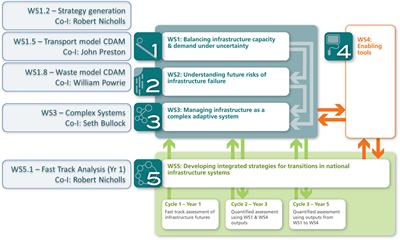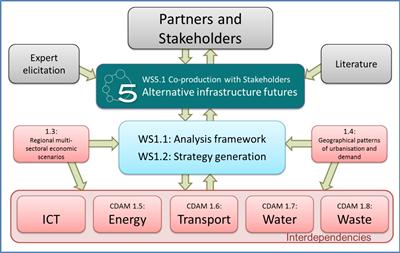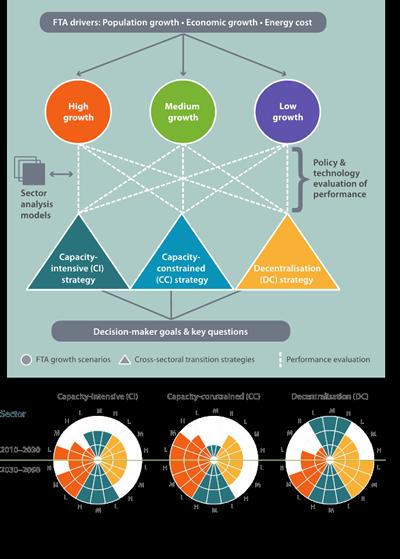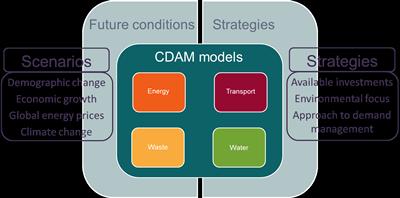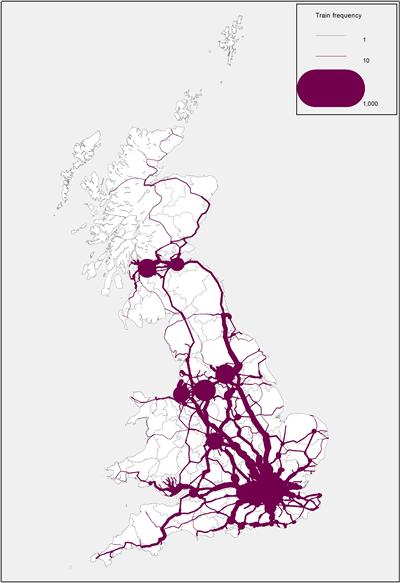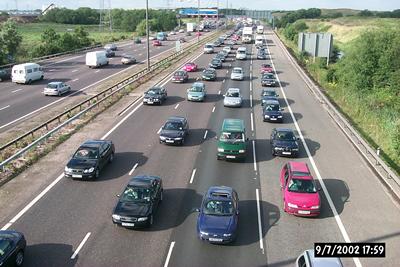A nation’s economic prosperity and societal wellbeing relies on high-quality infrastructure, particularly those essential services and systems which transport key resources and enable global communications.
The UK Infrastructure Transitions Research Consortium (ITRC www.itrc.org.uk) is helping to inform the analysis, planning and design of national infrastructure, through the development and demonstration of new decision support tools, and working with partners in government and industry in the UK and abroad.
ITRC delivers research, models and decision support tools to enable analysis and planning of a robust national infrastructure system. Infrastructure assets (in energy, transport, water and waste) have a long lifespan and require substantial investment, making planning for the future of such systems a difficult task, particularly given potentially limited funds in the near future; the research addresses these challenges.
In the first five-year programme, the consortium brought together seven leading UK universities to deliver research that:
-
developed a series of long term visions for national infrastructure in the UK;
-
modelled the interdependencies between infrastructure sectors, such as between the transport and energy systems;
-
analysed the vulnerabilities and risks of infrastructure failure, particularly due to extreme weather events and the longer term impact of climate change, as well as the future reliance of interconnected infrastructure systems on ICT;
-
explored the relationship between infrastructure and economic growth.
MISTRAL (Multiscale Infrastructure Systems Transition Analytics) is phase 2 of the research programme, expanding the scale and reach of our NISMOD system. ITRC’s vision is for complex infrastructure decisions to be guided by our systems analysis ability. Using the pioneering tools developed by the ITRC team, decision-makers are able to visualise and assess how all of their infrastructure systems are performing, help to pinpoint vulnerabilities and quantify the risks of failure. The tools are capable of performing ‘what-if’ analysis of proposed investments and exploring the effects of future uncertainties, such as population growth, new technologies and climate change. A key feature of the ITRC projects has been a high level of engagement with industry and government, and the modelling tools produced as part of ITRC and MISTRAL have been used by the National Infrastructure Commission to inform their National Needs Assessment.
Work at Southampton includes a focus on enhancing the transport models developed during ITRC phase 1. This centres on developing an integrated framework covering capacity, demand and risk, and incorporating a network-based representation of the British transport system. The scope of the model will also be extended to cover key international linkages. Tasks include generating a base year OD matrix for Great Britain, parameterising transport interventions and policies for inclusion in the model using the best available evidence, constructing a flexible network-based national transport model, developing meta-models or emulators to represent local transport within this model, and integrating risk and resilience modelling into the wider framework.
University researchers are also involved in other MISTRAL work, aiming to adapt and apply the systems-of-systems infrastructure assessment capabilities to other locations including developing countries, rapidly developing city-states, and post-conflict, post-disasters contexts. Together with researchers from Oxford University, and in collaboration with the United Nations Office for Project Services (UNOPS), a series of open-source analysis tools known as NISMOD-Int is being developed for the application of evidence-based decision making to developing countries. The initial focus has been on the infrastructure needs of Palestine, and a ‘fast-track’ report will be completed during the first half of 2017.”
In phase 1 of the ITRC programme, the research dealt at a national scale with: energy, transport, water, waste, and information and communication technologies (ICT) systems.
For these systems, the programme:
-
Developed new methods for analysing performance, risks and interdependencies
-
Provided a virtual environment in which to test strategies for long term investment
-
Developed methodologies to help understand how alternative strategies perform with respect to policy constraints such as:
-
reliability and security of supply
-
cost
-
carbon emissions, and
-
adaptability to demographic and climate change
The Consortium is led by the University of Oxford, but the University of Southampton is leading work in a number of areas.
Southampton and Oxford were together responsible for the co-production (with stakeholders) of the major outputs from the original project, culminating I the publication of a book entitled ‘The Future of National Infrastructure: A System-of-systems approach’ published by Cambridge University Press in 2016.
The Transport Model
The model which has been developed by the Transportation Research Group for the transport infrastructure network is capable of forecasting road and rail transport demand and capacity within and between 144 zones covering the whole of Great Britain for the period up to 2100. It also produces similar forecasts for 28 airports and 47 seaports, and provides estimates of transport fuel consumption and carbon emissions. The model has been used to forecast the impact of seven different future transport strategies under three external scenarios, covering changes in population, economic growth and energy prices. The transport strategies include factors such as changing vehicle fuel efficiencies and power sources, the implementation of congestion and carbon-based tolls and workplace parking levies, and varying levels of infrastructure construction. Work is currently taking place to extend the model to include explicit interactions with models of other infrastructure sectors, so that interdependencies between systems can be modelled over time.
